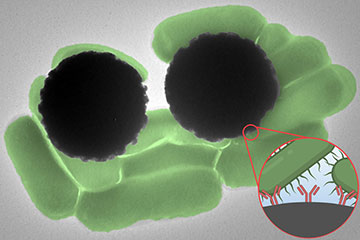
Dynabeads, which are antibody-coated superparamagnetic beads, serves as a strong Raman reporter for the simultaneous capture and detection of pathogenic bacterium such as Salmonella. The image shows the Dynabeads (gray spheres) interacting with Salmonella bacterium (in green). The inset shows the Y-shaped antibody coating of the Dynabeads. [Image: courtesy of Loza Tadesse, Marissa McDonald et al.]
Dynabeads—magnetizable beads coated with antibodies that bind to target molecules—are a common tool for separating and purifying cells and biomolecules. Now researchers at the Massachusetts Institute of Technology (MIT), USA, have identified a new application for Dynabeads as Raman probes for detecting targets in diagnostic tests (J. Raman Spectrosc., doi: 10.1002/jrs.6584). In experiments with Salmonella enterica, the microscopic beads provided a rapid, sensitive and specific approach for indirect bacterial detection.
Discovering a Raman signature
Invented more than four decades ago, Dynabeads consist of an iron-oxide core and polystyrene coating. They become magnetically activated in the presence of an external magnetic field, a characteristic that has proved beneficial for cell separation. However, detection of captured targets with Dynabeads remains challenging and tedious, often requiring culturing or molecular-based techniques such as polymerase chain reaction and enzyme immunoassays.
The team lead on the new study, Loza Tadesse, and her MIT colleagues found that Dynabeads also have a unique Raman signature that opens the door to a scalable, simple detection scheme. Like a fluorescent tag, the Raman signal can confirm within less than an hour whether or not a target molecule, such as a pathogen, is present in a given sample.
“We realized this signal could be a means of reporting to you whether you have that bacteria or not.” —Loza Tadesse
“We were initially seeking to identify the signatures of bacteria, but the signature of the Dynabeads was actually very strong,” Tadesse said in a press release accompanying the research. “We realized this signal could be a means of reporting to you whether you have that bacteria or not.”
Within half a second
The researchers mixed Dynabeads coated with anti-Salmonella antibodies into vials of water contaminated with Salmonella enterica, which is the leading cause of hospitalizations and death due to foodborne illness. They magnetically isolated cells in the sample and collected Raman spectra in both single-point-detection and mapping modes with a 785-nm incident laser.
Within half a second, Tadesse and her colleagues detected a Raman signature that verified the presence of Dynabeads bound to the bacteria. Single and clustered beads provided a 44- and 68-fold greater Raman intensity compared with the signature from cells alone. The researchers now aim to adapt the elements of the system into smaller, more portable forms, as well as test conditions such as sepsis, which are not rapidly detected using conventional lab tests.
“Salmonella is the proof of concept,” said Tadesse. “You could purchase Dynabeads with E. coli antibodies, and the same thing would happen: It would bind to the bacteria, and we’d be able to detect the Dynabead signature because the signal is super-strong.”
